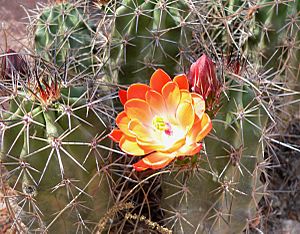Echinocereus arizonicus facts for kids
Quick facts for kids Echinocereus arizonicus |
|
|---|---|
 |
|
| Conservation status | |
| Scientific classification | |
| Synonyms | |
|
The Echinocereus arizonicus is a special type of cactus. It is often called the Arizona claret-cup cactus or Arizona hedgehog cactus. This plant grows naturally in the dry, sunny lands of the Chihuahuan Desert. You can find it in parts of Chihuahua in Mexico. It also lives in the southwestern United States. This includes areas of New Mexico and southeastern Arizona.
This unique cactus also grows in specific mountain ranges. These are the Superstition and Mescal Mountains in central Arizona.
Contents
What Does the Arizona Cactus Look Like?
The Echinocereus arizonicus is known for its beautiful flowers. These flowers are usually a deep red color. Sometimes they can be bright orange-red. The center of the flower might be a lighter yellowish-green. This makes them stand out in the desert landscape.
Where Does This Cactus Live?
This cactus loves dry, desert environments. The Chihuahuan Desert is a large desert area. It stretches across parts of Mexico and the United States. The cactus is well-suited to living in these hot, dry conditions. It can store water in its thick stems.
Special Mountain Homes
Some specific places are very important for this cactus. The Superstition Mountains, Mescal Mountains, and Pinal Mountains in Arizona are key. These mountains provide the right conditions for the cactus to grow.
Protecting a Rare Cactus
There is a very special type of this cactus. It is called "Echinocereus triglochidiatus arizonicus". This specific type is quite rare. It is found only in certain parts of the Superstition, Mescal, and Pinal Mountains. Scientists have studied its genes. They found that this rare type does not grow anywhere else.
Why is it Important to Protect Rare Plants?
When a plant is found in only a few places, it is more vulnerable. This means it could be easily lost forever. Protecting plants like the Echinocereus triglochidiatus arizonicus is very important. It helps keep our planet's plant life diverse. It also protects the unique ecosystems where they live.
See also
 In Spanish: Echinocereus coccineus para niños
In Spanish: Echinocereus coccineus para niños


